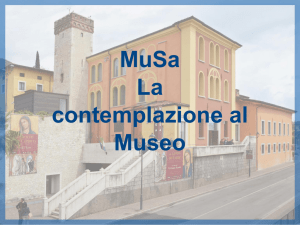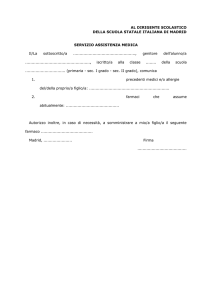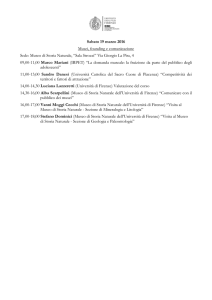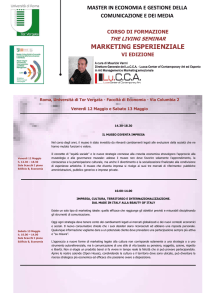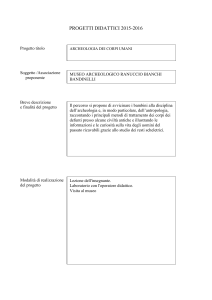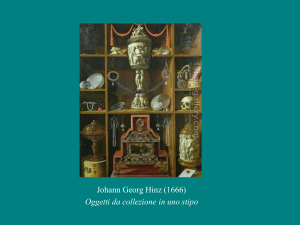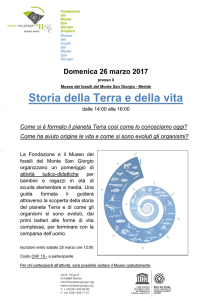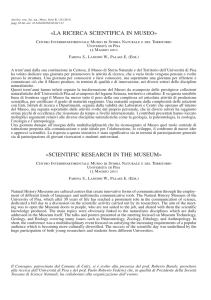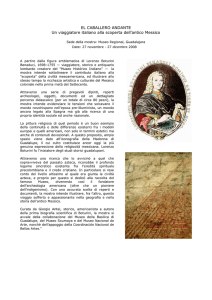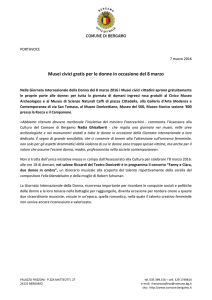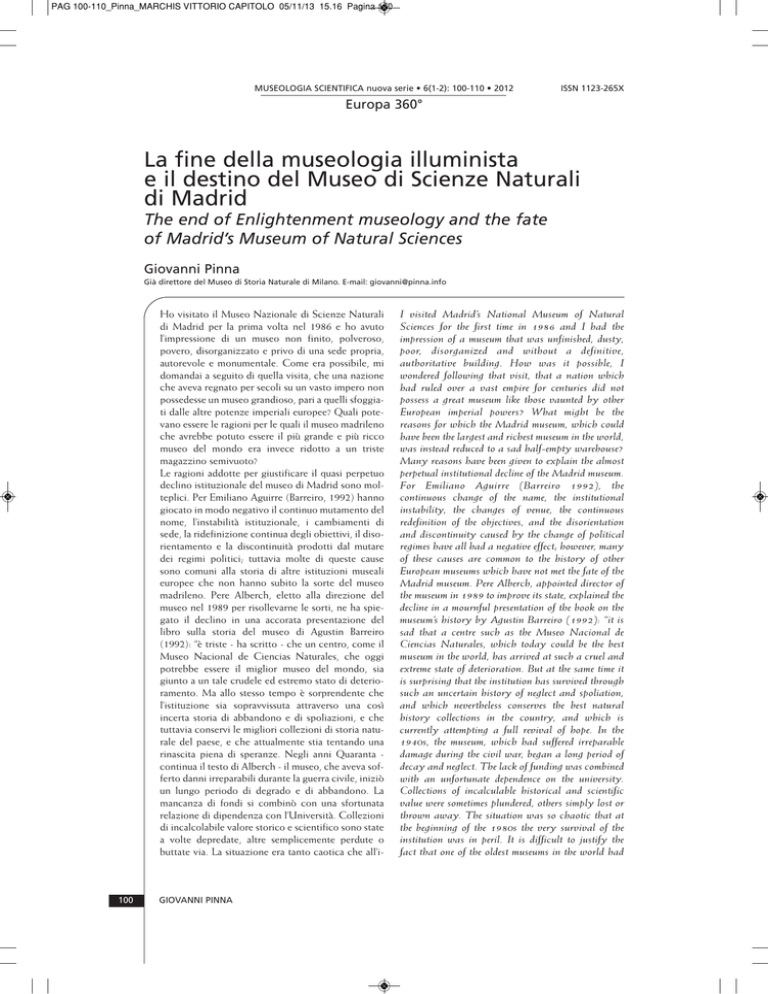
PAG 100-110_Pinna_MARCHIS VITTORIO CAPITOLO 05/11/13 15.16 Pagina 100
MUSEOLOGIA SCIENTIFICA nuova serie • 6(1-2): 100-110 • 2012
ISSN 1123-265X
Europa 360°
La fine della museologia illuminista
e il destino del Museo di Scienze Naturali
di Madrid
The end of Enlightenment museology and the fate
of Madrid’s Museum of Natural Sciences
Giovanni Pinna
Già direttore del Museo di Storia Naturale di Milano. E-mail: [email protected]
Ho visitato il Museo Nazionale di Scienze Naturali
di Madrid per la prima volta nel 1986 e ho avuto
l’impressione di un museo non finito, polveroso,
povero, disorganizzato e privo di una sede propria,
autorevole e monumentale. Come era possibile, mi
domandai a seguito di quella visita, che una nazione
che aveva regnato per secoli su un vasto impero non
possedesse un museo grandioso, pari a quelli sfoggiati dalle altre potenze imperiali europee? Quali potevano essere le ragioni per le quali il museo madrileno
che avrebbe potuto essere il più grande e più ricco
museo del mondo era invece ridotto a un triste
magazzino semivuoto?
Le ragioni addotte per giustificare il quasi perpetuo
declino istituzionale del museo di Madrid sono molteplici. Per Emiliano Aguirre (Barreiro, 1992) hanno
giocato in modo negativo il continuo mutamento del
nome, l’instabilità istituzionale, i cambiamenti di
sede, la ridefinizione continua degli obiettivi, il disorientamento e la discontinuità prodotti dal mutare
dei regimi politici; tuttavia molte di queste cause
sono comuni alla storia di altre istituzioni museali
europee che non hanno subito la sorte del museo
madrileno. Pere Alberch, eletto alla direzione del
museo nel 1989 per risollevarne le sorti, ne ha spiegato il declino in una accorata presentazione del
libro sulla storia del museo di Agustin Barreiro
(1992): “è triste - ha scritto - che un centro, come il
Museo Nacional de Ciencias Naturales, che oggi
potrebbe essere il miglior museo del mondo, sia
giunto a un tale crudele ed estremo stato di deterioramento. Ma allo stesso tempo è sorprendente che
l’istituzione sia sopravvissuta attraverso una così
incerta storia di abbandono e di spoliazioni, e che
tuttavia conservi le migliori collezioni di storia naturale del paese, e che attualmente stia tentando una
rinascita piena di speranze. Negli anni Quaranta continua il testo di Alberch - il museo, che aveva sofferto danni irreparabili durante la guerra civile, iniziò
un lungo periodo di degrado e di abbandono. La
mancanza di fondi si combinò con una sfortunata
relazione di dipendenza con l’Università. Collezioni
di incalcolabile valore storico e scientifico sono state
a volte depredate, altre semplicemente perdute o
buttate via. La situazione era tanto caotica che all’i-
100
GIOVANNI PINNA
I visited Madrid’s National Museum of Natural
Sciences for the first time in 1986 and I had the
impression of a museum that was unfinished, dusty,
poor, disorganized and without a definitive,
authoritative building. How was it possible, I
wondered following that visit, that a nation which
had ruled over a vast empire for centuries did not
possess a great museum like those vaunted by other
European imperial powers? What might be the
reasons for which the Madrid museum, which could
have been the largest and richest museum in the world,
was instead reduced to a sad half-empty warehouse?
Many reasons have been given to explain the almost
perpetual institutional decline of the Madrid museum.
For Emiliano Aguirre (Barreiro 1992), the
continuous change of the name, the institutional
instability, the changes of venue, the continuous
redefinition of the objectives, and the disorientation
and discontinuity caused by the change of political
regimes have all had a negative effect; however, many
of these causes are common to the history of other
European museums which have not met the fate of the
Madrid museum. Pere Alberch, appointed director of
the museum in 1989 to improve its state, explained the
decline in a mournful presentation of the book on the
museum’s history by Agustin Barreiro (1992): “it is
sad that a centre such as the Museo Nacional de
Ciencias Naturales, which today could be the best
museum in the world, has arrived at such a cruel and
extreme state of deterioration. But at the same time it
is surprising that the institution has survived through
such an uncertain history of neglect and spoliation,
and which nevertheless conserves the best natural
history collections in the country, and which is
currently attempting a full revival of hope. In the
1940s, the museum, which had suffered irreparable
damage during the civil war, began a long period of
decay and neglect. The lack of funding was combined
with an unfortunate dependence on the university.
Collections of incalculable historical and scientific
value were sometimes plundered, others simply lost or
thrown away. The situation was so chaotic that at
the beginning of the 1980s the very survival of the
institution was in peril. It is difficult to justify the
fact that one of the oldest museums in the world had
PAG 100-110_Pinna_MARCHIS VITTORIO CAPITOLO 05/11/13 15.16 Pagina 101
nizio della decade degli anni Ottanta era in pericolo
la sopravvivenza dell’istituzione. È difficile giustificare il fatto che uno dei musei più antichi del mondo
sia giunto a questo punto estremo di deterioramento.
Non è possibile giustificarlo, però è facile spiegarlo
nel quadro di governi e di una società che, come la
nostra, non ha valorizzato in modo sufficiente né la
natura, né la scienza.” Pere Alberch, di cui ricordo
con simpatia le discussioni che abbiamo avuto nel
corso degli annuali incontri dei direttori dei sette
maggiori musei naturalistici d’Europa (Madrid,
Parigi, Londra, Stoccolma, Francoforte, Vienna,
Milano), non ha potuto vedere la rinascita del
museo, pur essendone stato il promotore, stroncato
da una malattia nel 1998.
Certo, la mancanza di autonomia, di una propria
sede monumentale e la dipendenza dall’università e
da altri organi nazionali che hanno caratterizzato la
storia del museo, non hanno giovato alla sua crescita
e allo sviluppo delle sue attività scientifiche, come
non sono stati favorevoli la dominazione napoleonica, la guerra civile e la dittatura franchista. Io credo
tuttavia che la ragione di fondo della debole consistenza del museo madrileno vada ricercata altrove;
nel fatto cioè che l’avvenimento che ne decise la
decadenza e ne impedì lo sviluppo si verificò nel
periodo in cui ebbe luogo la più profonda rivoluzione di tutta la storia dell’istituzione museale: la transizione dal Cabinet illuminista al museo nazionalista.
Questa trasformazione seguì rivolgimenti culturali,
sociali e politici che coinvolsero l’Europa a seguito
della Rivoluzione Francese e delle guerre napoleoniche, e che nella pratica politica sostituirono l’utopia
illuminista con le teorie nazionaliste, più efficaci poiché funzionali alla nascita del concetto politico di
nazione. Coinvolte nelle dottrine illuministe, già
prima della Rivoluzione Francese alcune corti europee avevano aperto a un pubblico selezionato le proprie collezioni d’arte e i propri gabinetti di curiosità
naturali, che il permanere della proprietà esclusiva
della corona rendevano però estranei all’idea che
potessero essere patrimonio di tutta la nazione. Fu
con la trasformazione del Louvre in museo pubblico
nel 1792, e con la trasformazione l’anno successivo
del Jardin du Roi in istituto pubblico, con il nome di
Muséum National d’Histoire Naturelle, che per la
prima volta il gabinetto illuminista e le collezioni
d’arte principesche divennero proprietà della nazione, assumendo il compito di fornire ad essa identità
e autorevolezza attraverso l’illustrazione di una storia
millenaria, di un’arte fiorente, di una cultura profonda, o dimostrando una potenza militare capace di
accumulare e esporre le spoglie delle culture sottomesse. Nel decennio che seguì la caduta di
Napoleone, tutti gli stati-nazione europei si dotarono di musei d’arte nazionali sul modello del Louvre,
o trasformarono i loro gabinetti scientifici in istituzioni pubbliche.
come to this extreme point of deterioration. It is
impossible to justify it, but it is easy to explain it
within the framework of governments and a society
which, like ours, did not sufficiently value either
nature or science.” Pere Alberch, of whom I recall
with affection the discussions we had during the
annual meetings of the directors of the seven major
European natural history museums (Madrid, Paris,
London, Stockholm, Frankfurt, Vienna, Milan), was
unable to witness the rebirth of the museum, even
though he had been its promoter, since he died of an
illness in 1998.
Certainly the lack of autonomy, of its own building
and the dependence on the university and on other
national institutions that have characterized the
history of the museum did not help its growth and the
development of its scientific activities, just as the
Napoleonic domination, the Civil War and Franco’s
dictatorship were unfavourable. I believe, however,
that the fundamental reason for the weakness of the
Madrid museum must be sought elsewhere, namely in
the fact that the event that decided its decadence and
prevented its development occurred in the period in
which the most profound revolution in the entire
history of the museum took place: the transition from
the Enlightenment cabinet to the nationalist museum.
This transformation followed the cultural, social and
political upheavals in Europe following the French
Revolution and the Napoleonic Wars; in political
practices, these upheavals replaced the Enlightenment
utopia with nationalist theories, which were more
effective for the birth of the political concept of nation.
Some European courts, embracing Enlightenment
doctrines even before the French Revolution, had
opened their art collections and their rooms of natural
curiosities to a select audience, even though the fact
that they remained the sole property of the crown
excluded them from the idea of becoming a patrimony
of the entire nation. It was only with the
transformation of the Louvre into a public museum in
1792 and the transformation of the Jardin du Roi
into a public institution in the following year (with
the name Muséum national d’Histoire naturelle) that
for the first time the Enlightenment cabinet and
princely art collections became the property of the
nation, taking on the task of providing it with an
identity and authority through the illustration of an
ancient history, a flourishing art, a deep culture, or
demonstrating a military power capable of
accumulating and exhibiting the spoils of subjected
cultures. In the decade after the fall of Napoleon, all
European nation-states acquired national art
museums on the model of the Louvre, or transformed
their scientific laboratories into public institutions.
The history of Spanish museums followed the same
path. Enlightenment ideas appeared in Spain after the
war of succession that deposed the Habsburgs and
placed the Bourbons, who were less foreign to the
LA FINE DELLA MUSEOLOGIA ILLUMINISTA E IL DESTINO DEL MUSEO DI SCIENZE NATURALI DI MADRID
101
PAG 100-110_Pinna_MARCHIS VITTORIO CAPITOLO 05/11/13 15.16 Pagina 102
In Spagna la storia dei musei seguì lo stesso percorso.
Qui le idee illuministe avevano fatto capolino dopo
la guerra di successione che aveva spodestato gli
Asburgo e aveva posto sul trono di Spagna i Borboni,
meno estranei alle culture francese e italiana, e si diffusero soprattutto sotto il regno di Ferdinando VI e
del suo successore Carlo III, grazie alla loro politica
riformatrice detta del “dispotismo illuminato”.
Fu proprio sotto il regno di Ferdinando VI che al volgere della metà del secolo XVIII sbocciò il primo
germoglio dell’attuale Museo di Scienze Naturali di
Madrid. Nel 1752 il tenente generale dell’armata
reale Antonio de Ulloa, esploratore, scrittore e
scienziato noto per aver fornito la prima descrizione
del platino, presentò a Zenon de Somodevilla, marchese di Ensenada, potente ministro di Ferdinando
VI, un progetto per la creazione di un gabinetto di
storia naturale, sul modello di quelli che già esistevano in altri paesi europei. A questa proposta seguì
nello stesso anno la creazione della Real Casa de
Geografia, in cui avrebbero dovuto confluire collezioni di storia naturale acquistabili sul mercato europeo, ma soprattutto provenienti dai domini spagnoli
d’oltremare, cui Ensenada aveva inviato una circolare
con l’ordine di raccogliere e inviare a Madrid minerali, e “produciones naturales y curiosa”. Tuttavia il
progetto di Ulloa non ebbe la possibilità di svilupparsi; la nuova istituzione, albergata in una casa del
tutto inadeguata in Calle della Magdalena nel quartiere Lavapiés, iniziò a languire per il disinteresse
della Casa Reale e del Governo; nel 1755 gli strumenti, i libri e gli oggetti furono passati a altre istituzioni e nello stesso anno Ulloa si dimise da direttore. Dovettero passare undici anni prima che la speranza di creare un gabinetto di scienze naturali facesse di nuovo capolino, grazie alla pubblicazione nel
1766 di uno scritto dello storico Enrique Flórez sulla
“Utilidad de la historia natural”, nel quale l’autore
incitava la Spagna a dotarsi di un gabinetto di scienze naturali simile a quelli che già esistevano in
Europa. “É cosa considerevole - si legge nel libretto
di Flórez - l’attenzione con cui tutte la nazioni colte
d’Europa promuovono e si impegnano nel formare
Collezioni di Storia Naturale, impiegando grandi
mezzi e pubblicando libri con grandi spese (…).
Non solo i Principi e i Corpi Accademici, ma anche
i privati di ambo i sessi si vantano di avere un
Gabinetto (…). Solo la Spagna, che è stata favorita
dalla natura, le è meno riconoscente, per non aver
volto la sua attenzione a ciò che ha in casa” (in
Pelayo, 1996). L’occasione si presentò verso gli anni
Settanta, quando l’appassionato naturalista Pedro
Franco Dávila offrì allo stato spagnolo la possibilità
di comprare le collezioni che aveva riunito a Parigi.
La transazione ebbe luogo nel 1771 attraverso l’intermediazione del segretario di stato Gerolamo
Grimaldi e soprattutto di Enrique Flórez, e nel 1774
un decreto del Re Carlo III diede vita al Real
102
GIOVANNI PINNA
French and Italian cultures, on the throne of Spain;
these ideas spread mainly under the reign of
Ferdinand VI and his successor Charles III due to
their reform policy known as “enlightened despotism”.
Under the reign of Ferdinand VI, the first version of
the present-day Museum of Natural Sciences was
established in Madrid in the mid-18th century. In
1752, the Lieutenant General of the royal army
Antonio de Ulloa, an explorer, writer and scientist
known for providing the first description of platinum,
presented to Zenon de Somodevilla, Marquis of
Ensenada and a powerful minister of Ferdinand VI,
a project for the creation of a natural history
laboratory on the model of those already existing in
other European countries. This proposal was
followed in the same year by the creation of the Real
Casa de Geografia, meant to house natural history
collections purchased on the European market but
particularly deriving from the Spanish dominions
overseas to which Ensenada had sent a circular with
orders to collect and send minerals and “produciones
naturales y curiosa” to Madrid. Yet Ulloa’s project
had no chance of developing; the new institution,
lodged in a completely inadequate house in Calle
della Magdalena in the Lavapies quarter, began to
languish on account of a lack of interest by the
Royal House and the Government. In 1755, the
instruments, books and other objects passed to other
institutions and in the same year Ulloa resigned as
director. Eleven years were to pass before the hope of
creating a natural sciences laboratory was raised
once again thanks to the publication in 1766 of a
text by the historian Enrique Flórez entitled “Utilidad
de la historia natural”, in which the author urged
Spain to acquire a natural science laboratory similar
to those already existing in Europe. “It is remarkable
- we read in Flórez’s pamphlet - the care with which
all the cultured nations of Europe promote and engage
in the formation of Natural History Collections,
employing great means and publishing books at great
expense (…). Not only Princes and Academic
Bodies, but also private individuals of both sexes
boast of having a Cabinet (…). Only Spain,
although favoured by nature, is less grateful to it, as
the nation has not turned its attention to what it has
at home” (in Pelayo pp. 262-263). The opportunity
came in the 1779s, when the keen naturalist Pedro
Franco Dávila offered the Spanish state the
opportunity to buy the collections that he had
assembled in Paris. The transaction took place in
1771 through the intermediation of the Secretary of
State Gerolamo Grimaldi and especially Enrique
Flórez. In 1774, a decree of King Charles III
established the Real Gabinete de Historia Natural,
which opened to the public on 4 November 1776 at
number 13 Calle de Alcalá in the building called
Real Casa de la Accademia de las tres Nobles Artes
y Gabinete, since it was home to both the Real
PAG 100-110_Pinna_MARCHIS VITTORIO CAPITOLO 05/11/13 15.16 Pagina 103
Gabinete de Historia Natural, che apri al pubblico il
4 novembre 1776 al numero 13 della calle de Alcalá,
nel palazzo detto Real Casa de la Accademia de las
tres Nobles Artes y Gabinete, in quanto ospitava sia
la Real Accademia de Bellas Artes de San Fernando,
sia il nuovo Gabinete, nella prima di una infinita
serie di coabitazioni.
Quella che avrebbe potuto essere una grande svolta
nella storia del Museo di Scienze Naturali di Madrid,
capace di renderlo un museo “imperiale” pari a quelli
di Parigi, di Londra o di Vienna, si presentò nel
1785, quando Carlo III affidò all’architetto Juan de
Villanueva il compito di progettare un grande museo
per le collezioni naturalistiche da erigere nel Prado
de San Jerónimo non lontano dal palazzo del Buen
Retiro. Tuttavia il progetto di Carlo III di dotare la
nazione di un grande museo per le scienze naturali
naufragò a causa dell’occupazione francese e degli
eventi politici e delle trasformazioni culturali che
seguirono le guerre napoleoniche. Dopo il dissolvimento dell’impero napoleonico, infatti, le monarchie
europee restaurate misero in atto politiche nazionaliste che infransero il progetto illuminista di una cultura paneuropea che Napoleone aveva perseguito, e
diedero ai musei obbiettivi più squisitamente politici. In Spagna questa trasformazione dei musei da istituzioni essenzialmente culturali a strumenti decisamente politici segnò il destino delle collezioni naturalistiche nazionali. Restaurata la monarchia borbonica, Ferdinando VII decise anch’egli, come altri
monarchi europei, di creare un museo d’arte che
incarnasse lo spirito della nazione e ordinò che nel
progettato palazzo del Prado de San Jerónimo fossero riunite le collezioni reali d’arte che erano sparse in
varie dimore, dal Buen Retiro all’Escorial, dal palazzo
reale di Aranjuez al Pardo. Così, nel 1819 fu inaugurato il Museo del Prado, un museo d’arte nazionale
da far invidia alle collezioni inglesi, austriache, russe
e francesi, mentre per le collezioni naturalistiche iniziò un periodo di lunghe peregrinazioni.
Queste peraltro erano state saccheggiate durante
l’occupazione francese e in parte trasportate in
Francia. Il saccheggio delle collezioni del palazzo
del calle de Alcalá fu un brutto episodio che ebbe
come protagonista un certo Pascual Moineau di
nazionalità francese, che era stato l’anatomista del
Gabinete. “Pare che la soldataglia francese che
distrusse il Laboratorio di Chimica (a quel tempo
uno dei maggiori d’Europa) appropriandosi inoltre di
molte capsule di platino - racconta Agustín Barreiro
- non fosse riuscita a entrare nel Gabinetto Reale, e
così fu fino al 1813. In quest’anno questo fu vittima
di un iniqua espropriazione, nel quale ebbe una parte
molto attiva Pascual Moineau, anatomista dell’istituto da cui aveva dato le dimissioni nel 1808. Né la
nobile ospitalità che aveva ricevuto (…), né il rispetto per il proprio onore, né il sentimento di rispetto
per la proprietà altrui, furono ostacoli per impedirgli
Accademia de Bellas Artes de San Fernando and the
new Gabinete, in the first of an endless series of
cohabitations.
What could have been a major turning point in the
history of Madrid’s Museum of Natural Sciences,
able to make it an “imperial” museum equal to those
of Paris, London or Vienna, was almost realized in
1785 when Charles III commissioned the architect
Juan de Villanueva to design a large museum for the
natural history collections to be erected in the Prado
de San Jerónimo not far from the Buen Retiro Palace.
However, Charles III’s project of giving the nation a
large museum for the natural sciences was ruined by
the French occupation and by the political events and
cultural transformations that followed the
Napoleonic wars. After the dissolution of the
Napoleonic empire, the restored European monarchies
enacted nationalist policies that shattered the
Enlightenment project of a pan-European culture
which Napoleon had pursued and gave the museum
more purely political objectives. In Spain, this
transformation of museums from essentially cultural
institutions to decidedly political tools sealed the fate
of the national natural history collections. After
restoration of the Bourbon monarchy, Ferdinand VII
decided, like other European monarchs, to create an
art museum embodying the spirit of the nation and
ordered that the royal art collections scattered in
various residences, e.g. the Buen Retiro at Escorial,
the Royal Palaces of Aranjuez and of El Pardo, be
united in the planned building in Prado de San
Jerónimo. Thus, the Prado Museum was inaugurated
in 1819, a national art museum rivalling the English,
Austrian, Russian and French collections, while the
natural history collections began a long period of
peregrinations.
Moreover, the collections had been plundered during
the French occupation and in part transported to
France. The looting of the collections of the building
in Calle de Alcalá was an ugly episode whose
protagonist was the Frenchman Pascual Moineau,
who had been the anatomist of the Gabinete. As
Agustin Barreiro recounted, “It seems that the French
soldiery which destroyed the Chemistry Laboratory
(at that time one of the largest in Europe), also
misappropriating many platinum capsules, was
unable to enter the Royal Cabinet, and this persisted
until 1813. In that year, the Cabinet was the victim
of an iniquitous expropriation, in which a very
active part was taken by Pascual Moineau,
anatomist of the institute until his resignation in
1808. Neither the noble hospitality he had received
(...), nor the respect for his honour, nor the feeling of
respect for the property of others, were obstacles
preventing him from committing such treason. In the
cited year (we do not know the exact date), he
presented himself at the gates of the Cabinet
accompanied by troops which forced them open with
LA FINE DELLA MUSEOLOGIA ILLUMINISTA E IL DESTINO DEL MUSEO DI SCIENZE NATURALI DI MADRID
103
PAG 100-110_Pinna_MARCHIS VITTORIO CAPITOLO 05/11/13 15.16 Pagina 104
di commettere tale tradimento. Nell’anno citato
(non si conosce la data esatta) egli si presentò alle
porte del Gabinetto accompagnato da truppe che le
forzarono con violenza, e da li portò via e caricò su
carri 200 oggetti consistenti in ceramiche artistiche,
vasi, pietre preziose, ecc.. Manuel Cástor (allora
Direttore del Gabinetto n.d.a) e i compagni osservarono indignati una scena così scandalosa, e con il
fine di bloccare per tempo il furto, avvisarono El
Empecinado (alias Juan Martín Díez, militare spagnolo eroe della guerra per l’indipendenza contro
Napoleone n.d.a.) che in quel momento operava da
qualche parte nelle campagne di Alcalá. Moineau e i
suoi carri erano custoditi da molti soldati e fu perciò
impossibile catturarli; per colmo della disgrazia il
Governo straniero entrò in possesso dell’avvertimento di Cástor, assieme a altre carte del citato guerrigliero e sia Cástor, sia Antonio (Antonio Rodríguez
marmista del Gabinetto n.d.a) e Vincente Pastor che
erano stati i latori del citato messaggio, furono condotti al Retiro e sottoposti a un consiglio di guerra
che li condannò alla fucilazione. Per un avvenimento
provvidenziale, i cui dettagli non abbiamo cercato di
scoprire, ebbero salva la vita, mentre i tesori del
Gabinetto continuavano il loro cammino verso la
Francia.” Dopo la caduta di Napoleone il Real
Gabinete, che nel 1815 era divenuto Real Museo de
Ciencias Naturales, ritornò in possesso di parte delle
collezioni portate in Francia, fra cui il Tesoro del
Delfino, una collezione di oggetti e pietre preziose
che nel 1839 fu però incorporata nel Museo del
Prado, ove si trova tuttora.
Gli anni che seguirono la liberazione videro il succedersi di spostamenti di sede che poco giovarono alla
crescita del museo. Questo, con il nome di Museo de
Ciencias Naturales assunto nel 1868, dovette trasferire le collezioni dal calle de Alcalá in alcune sale di
un palazzo del Paseo de Recoletes destinato a divenire il Palacio de Bibliotecas Y Museos Nacionales.
Lo spostamento avvenne troppo velocemente e troppo disordinatamente, e le collezioni furono accumulate quasi senz’ordine nelle sale del nuovo edificio.
Queste erano però insufficienti a contenerle, il che
obbligò a destinare parte delle collezioni ad altri edifici. Nel palazzo di Recoletes rimasero le sale di
mineralogia, di geologia, di malacologia e quelle
destinate alle collezioni di uccelli e di mammiferi,
mentre il museo iniziò a perdere le proprie collezioni
a favore di musei di nuova istituzione, fra cui il
Museo Nacional de Antropologia. Nel 1907 il
museo, che dal 1913 ha il nome di Museo Nacional
de Ciencias Naturales, fu collocato nel grande
Palazzo dell’Industria e delle Arti lungo il Paseo de la
Castellana (fig. 1) che era stato inaugurato nel 1887
in occasione dell’Esposizione Nazionale di Belle
Arti, per essere sede di esposizioni temporanee, non
solo di belle arti, sulla falsa riga dei Salons parigini,
ma anche di prodotti industriali. Questo palazzo
104
GIOVANNI PINNA
violence, and from there carried away and loaded on
wagons 200 objects consisting in artistic ceramics,
vases, precious stones, etc. Manuel Cástor (author’s
note: then Director of the Cabinet) and his
companions observed this shocking scene with
outrage and, with the purpose of stopping the theft in
time, warned El Empecinado (author’s note: alias Juan
Martín Díez, Spanish military hero of the war of
independence against Napoleon), who at that time
was operating somewhere in the countryside of
Alcalá. Moineau and his wagons were guarded by
many soldiers and thus it was impossible to capture
them; to make the mishap even greater, the foreign
government came into possession of Cástor’s warning,
together with other documents of the aforesaid
military man, and Cástor, Antonio (author’s note:
Antonio Rodríguez, stonemason of the Cabinet) and
Vincente Pastor, who had been the bearers of the
above-mentioned message, were brought to the Retiro
and subjected to a war council which condemned
them to be shot. By a providential event, the details of
which we have not tried to discover, their lives were
saved, while the treasures of the Laboratory continued
on their journey to France.” After the fall of
Napoleon, the Real Gabinete, which in 1815 had
become the Real Museo de Ciencias Naturales,
regained possession of the collections taken to France;
they included the Dauphin’s Treasure, a collection of
objects and precious stones, which however was
added to the Prado Museum in 1839, where it is still
found.
The years following the liberation saw a succession
of location changes unfavourable to the growth of the
museum. Under the name Museo de Ciencias
Naturales acquired in 1868, it had to move the
collections from Calle de Alcalá into several rooms of
a building in Paseo de Recoletes destined to become
the Palacio de Bibliotecas Y Museos Nacionales.
The move was made too quickly and in a too
disorderly manner, and the collections were
accumulated almost without any order in the halls of
the new building. However, these halls were
insufficient to contain them, which forced the
allocation of part of the collections to other buildings.
In the Recoletes building, there remained the halls of
mineralogy, geology, malacology and those devoted
to collections of birds and mammals, while the
museum began to lose its collections to newly
established museums, including the Museo Nacional
de Antropologia. In 1907, the museum (called the
Museo Nacional de Ciencias Naturales since 1913)
was housed in the large Palace of Industry and Arts
in Paseo de la Castellana (Fig. 1), which had been
inaugurated in 1887 on the occasion of the National
Fine Arts Exhibition to be the site of temporary
exhibitions, not only of fine arts, along the lines of the
Parisian Salons, but also of industrial products.
This building, not conceived as a museum and partly
PAG 100-110_Pinna_MARCHIS VITTORIO CAPITOLO 05/11/13 15.16 Pagina 105
Fig. 1. Plastico del Palazzo dell’Industria e delle Arti in Paseo de la Castellana, sede attuale del museo.
Model of the Palace of Industry and Arts in Paseo de la Castellana, current home of the museum.
non concepito come sede museale, e in parte occupato dalla scuola degli ingegneri industriali del
Politecnico di Madrid, è l’attuale sede del museo e ne
condiziona profondamente le esposizioni che occupano due ali dell’edificio, cosicché le esposizioni
biologiche hanno un ingresso diverso da quelle geologico-paloeontologiche.
Il colpo più duro al museo di Madrid, dopo la perdita
del Prado, fu certamente quello inferto dalla politica
della dittatura franchista. Con il fine di subordinare
la scienza spagnola all’interpretazione in chiave reazionaria del cattolicesimo tipica della cultura franchista, il governo istituì nel 1939 il Consejo Superior
de Investigaciones Científicas (CSIC) il cui programma fu inciso nelle parole pronunciate nel
discorso inaugurale dal suo fondatore e primo presidente José Ibáñes Martin, membro dell’Asociación
Católica Nacional de Propagandistas, ministro dell’educazione del secondo governo di Franco e presidente del consiglio di Stato: “Vogliamo una scienza
cattolica. Liquidiamo, pertanto, nell’ora presente,
tutte le eresie scientifiche che essiccarono e resero
angusti gli alvei della nostra genialità nazionale e ci
sottomisero all’atonia e alla decadenza. (…) La
nostra scienza attuale, in continuità con quella dei
secoli passati che ci definì come nazione e come
impero, vuole essere soprattutto cattolica.” Questa
subordinazione è quasi universalmente considerata
la causa dell’arretratezza scientifica della Spagna
durante il franchismo e nei primi anni del postfranchismo; un’arretratezza di cui è stato vittima anche il
Museo Nacional de Ciencias Naturales che fu messo
alle dipendenze del CSIC (da cui ancora oggi dipen-
occupied by the industrial engineering school of the
Madrid Polytechnic, is still the home of the museum;
this profoundly affects the exhibits occupying two
wings of the building, so that the biological exhibits
have a different entrance from the geologicalpalaeontological ones.
The cruellest blow to the Madrid museum, after the
loss of the Prado, was certainly that inflicted by the
Franco dictatorship. With the aim of subjecting
Spanish science to interpretation by the reactionary
Catholicism typical of Francoist culture, the
government instituted the Consejo Superior de
Investigaciones Científicas (CSIC) in 1939. Its
program was summarized in the words spoken in the
inaugural speech by its founder and first president
José Ibanes Martin, a member of the Asociacion
Nacional Católica de Propagandistas, Minister of
Education in the second Franco government and
president of the council of state: “We want a Catholic
science. Therefore, we dismiss, at the present time, all
the scientific heresies that desiccated and diminished
the streambeds of our national genius and subjected us
to sluggishness and decadence. (...) Our current
science, in continuity with that of past centuries
which defined us as a nation and as an empire,
should above all be Catholic.” This subordination is
almost universally considered the cause of the
scientific backwardness of Spain during the Franco
era and in the first years of post-Francoism; the
Museo Nacional de Ciencias Naturales was also a
victim of this backwardness, as it was put under the
control of the CSIC (a situation that persists),
continuing its severe crisis which only ended with a
LA FINE DELLA MUSEOLOGIA ILLUMINISTA E IL DESTINO DEL MUSEO DI SCIENZE NATURALI DI MADRID
105
PAG 100-110_Pinna_MARCHIS VITTORIO CAPITOLO 05/11/13 15.16 Pagina 106
de) continuando la sua crisi profonda che terminò
con un primo riordinamento e la riapertura al pubblico nel 1984.
Ho visitato nuovamente il museo nell’estate del 2011
e rispetto alla mia prima visita ho trovato cambiamenti straordinari nelle esposizioni (v. il Catalogo
dell’esposizione, Gomis Blanco & Peña de Canus
Sàez, 2011). Queste sono realizzate secondo una
museografia naturalistica tradizionale che rifugge
dall’inutile iperspettacolarità: ampie vetrine con
chiari apparati didascalici, ricostruzioni spettacolari
fra cui notevole è quella di un grande Architeuthis (fig.
2), piacevoli ricostruzioni pittoriche nel settore
paleontologico (fig. 3), grande attenzione alla fauna,
alla mineralogia e alla paleontologia spagnole, un
ampio spazio didattico, una sezione sulla storia del
museo che espone alcuni pezzi delle antiche collezioni della Real Casa de Geografia e del Gabinete
del calle de Alcalà, un esauriente settore paleoantropologico e calchi di grandi scheletri di dinosauro.
Fra questi l’immancabile calco dello scheletro di
Diplodocus donato nel 1913 da Andrew Carnegie (fig.
4); immancabile perchè il magnate americano che
aveva finanziato lo scavo e il montaggio del fossile
ne aveva fatto eseguire molte copie che aveva poi
regalato ai governi dei maggiori paesi europei (quello donato al Re d’Italia fu destinato al museo
Cappellini di Bologna).
Quello di Madrid è dunque un museo tradizionale
che soffre della sua storia, che non ha potuto svilup-
Fig. 2. La ricostruzione di Architeuthis.
Reconstruction of Architeuthis.
106
GIOVANNI PINNA
first reorganization and reopening to the public in
1984.
I visited the museum again in the summer of 2011 and
I found extraordinary changes in the exhibits with
respect to my first visit (see the exhibition catalogue,
Gomis Blanco & Peña de Canus Sàez, 2011). They
were realized according to a traditional natural
history museography that avoided useless overspectacularity: large display cabinets with clear
information panels, spectacular reconstructions
including a remarkable large Architeuthis (fig. 2),
lovely
pictorial
reconstructions
in
the
palaeontological section (Fig. 3), great attention to
the Spanish fauna, mineralogy and palaeontology, a
large teaching area, a section on the history of the
museum displaying a few pieces of the old collections
of the Real Casa de Geografia and the Gabinete in
Calle de Alcalá, a comprehensive palaeoanthropology
section and casts of large dinosaur skeletons. Among
these is the ever-present cast of the Diplodocus
skeleton donated by Andrew Carnegie in 1913 (fig.
4); ever-present because the American tycoon, who
financed the excavation and mounting of the fossil,
made many copies of it which he then donated to the
governments of the major European countries (the one
donated to the King of Italy was sent to the
Cappellini Museum in Bologna).
Therefore, the Madrid institution is a traditional
museum which suffers from its history, since it has
been unable to develop in a manner worthy of a great
PAG 100-110_Pinna_MARCHIS VITTORIO CAPITOLO 05/11/13 15.16 Pagina 107
Fig. 3. Vetrina sull’estinzione di massa del Cretacico terminale, interpretata secondo la teoria, a mio avviso errata
ed anche obsoleta, dell’impatto meteorico (foto G. Pinna).
Display on the mass extinction at the end of the Cretaceous, interpreted according to the theory, in my opinion erroneous and also obsolete,
of an asteroid impact (photograph G. Pinna).
parsi nel modo degno di una grande nazione come la
Spagna per le vicende che ho narrato, per la scarsa
attenzione che i popoli mediterranei hanno per le
scienze, e che vede invece fiorire attorno a se ricchi
e scintillanti musei d’arte: il Prado, il Reina Sofia, il
Thyssen-Bornemisza.
Sperando che i conservatori non se ne abbiano a
male, e senza voler minimizzare l’importanza che le
collezioni del museo hanno per la Spagna, credo di
poter dire che il museo di Madrid è celebre soprattutto per un esemplare fossile, lo scheletro completo
del Megatherium americanum (fig. 5), cui è legata una
interessante vicenda che risale agli albori della scienza paleontologica. A cavallo fra il XVIII e il XIX
secolo questo fossile è stato infatti al centro di un
noto scandalo scientifico. Lo scheletro in questione
era stato trovato nel 1787 sulle sponde del fiume
Luján, non lontano da Buenos Aires, da un certo
padre domenicano Manuel de Torres che ne diede
notizia al Marchese de Loreto, Governatore del Rio
de la Plata. Su ordine di quest’ultimo i resti scheletrici furono inviati a Buenos Aires; qui lo scheletro fu
montato e successivamente smontato e disposto in
sette casse che furono inviate al Real Gabinete de
Historia Natural di Madrid ove giunsero nel 1788,
assieme ai disegni dello scheletro completo e delle
diverse ossa che erano stati eseguiti a Buenos Aires in
occasione del primo montaggio dell’esemplare. A
nation like Spain on account of the events that I have
narrated and the lack of attention that Mediterranean
peoples give to the sciences. In contrast, it is
surrounded by rich and sparkling art museums: the
Prado, the Reina Sofia, the Thyssen-Bornemisza.
In the hope that the curators will not be offended and
without minimizing the importance the museum’s
collections have for Spain, I think I can safely say
that the Madrid museum is best known for a fossil
specimen, a complete skeleton of Megatherium
americanum (Fig. 5), which is related to an
interesting story from the dawn of the science of
palaeontology. In the late 18th - early 19th century,
this fossil was at the centre of a well-known scientific
scandal. The skeleton had been discovered in 1787 on
the banks of the River Luján, near Buenos Aires, by
a Dominican priest Manuel de Torres who informed
the Marquis de Loreto, Governor of Rio de la Plata.
On the latter’s orders, the skeletal remains were sent to
Buenos Aires, where the skeleton was mounted and
then disassembled and placed in seven boxes. The
boxes were sent to the Real Gabinete de Historia
Natural in Madrid, where they arrived in 1788
along with drawings of the complete skeleton and the
various bones made in Buenos Aires when the
specimen was first mounted. In Madrid, the skeleton
was placed in the care of Juan Bautista Brú, a
painter and draftsman of the Royal Cabinet, who
LA FINE DELLA MUSEOLOGIA ILLUMINISTA E IL DESTINO DEL MUSEO DI SCIENZE NATURALI DI MADRID
107
PAG 100-110_Pinna_MARCHIS VITTORIO CAPITOLO 05/11/13 15.16 Pagina 108
Fig. 4. Calco dello scheletro di Diplodocus (in primo piano) (foto G. Pinna).
Cast of the Diplodocus skeleton (foreground) (photograph G. Pinna).
Madrid lo scheletro fu preso in carico da Juan
Bautista Brú, pittore e disegnatore del gabinetto
reale, che montò nuovamente lo scheletro ed effettuò 22 nuovi disegni, sia dello scheletro montato, sia
delle diverse ossa, che fece incidere da Joseph
108
GIOVANNI PINNA
remounted the skeleton and made 22 new drawings of
the mounted skeleton and the various bones, which he
had engraved by Joseph Ximeno and published in five
plates (Fig. 6a,b). The mounting of this skeleton was
an important event for palaeontology, since it was the
PAG 100-110_Pinna_MARCHIS VITTORIO CAPITOLO 05/11/13 15.16 Pagina 109
Fig. 5. Scheletro completo di Megatherium
americanum.
Complete skeleton of Megatherium americanum.
Ximeno e stampare in 5 tavole (fig. 6ab). Il montaggio di questo scheletro fu un avvenimento importante per la paleontologia, poiché fu in assoluto il primo
vertebrato fossile a essere esposto montato nella presunta posizione di vita. Fra i molti che vistarono il
museo di Madrid negli anni successivi, il danese
Abildgaard fu molto interessato allo scheletro dello
strano animale e su di esso pubblicò nel 1796 un
opuscolo di 14 pagine e una tavola. Quello che può
essere considerato l’artefice dello scandalo fu però il
francese Phileppe-Rise Roume, rappresentante del
governo francese a Santo Domingo, che, di passaggio a Madrid nel 1795, vide lo scheletro, ottenne le
prove di stampa di alcune tavole di Brú e non perse
l’occasione di inviarle, assieme a una descrizione,
all’abbè Grégoire membro dell’Istituto di Francia
(noto anche per essere il fondatore del Conservatoire des Arts et Métiers) che si premurò di presentarle all’Istituto, che a sua volta incaricò Georges
Cuvier di esaminarle.
Con la presentazione della documentazione a
Cuvier iniziò a prendere forma lo scandalo di cui ho
parlato. Infatti Cuvier, dopo aver riconosciuto che le
tavole non erano una frode e che lo scheletro raffiguratovi era senza dubbio quello di un animale sconosciuto, probabilmente prossimo agli sdentati (fra
gli armadilli e i bradipi), gli assegnò il nome di
Megatherium americanum in una nota del 1796, in cui
pubblicò anche due delle tavole di Brú. A seguito di
ciò, spinto evidentemente da una rivalsa nazionalista, l’ingegnere José Garriga decise di pubblicare le
tavole originali e la descrizione di Brú insieme alla
traduzione in spagnolo del testo di Cuvier. Nel 1804
Cuvier pubblicò un nuovo articolo sul Megatherium
incorporandovi la traduzione in francese della descrizione di Brú e un disegno dello scheletro completo che tuttavia non corrisponde perfettamente a
quello di Brú. Come era da aspettarsi, la vicenda ha
acceso una polemica che si trascina da tempo. I
paleontologi francesi difendono infatti l’integrità di
Cuvier, e sostengono, come Hoffstetter, che le tavo-
first vertebrate fossil to be displayed mounted in the
presumed life-like position. One of the many visitors
to the Madrid museum in the following years was the
Dane Abildgaard, who was very interested in the
skeleton of the strange animal and published a 14page booklet and a plate on it in 1796. However, the
person who can be considered the author of the
scandal was the Frenchman Phileppe-Rise Roume, a
representative of the French government in Santo
Domingo. While passing through Madrid in 1795,
he saw the skeleton, obtained the proofs of some of
Brú’s plates and sent them, along with a description,
to Abbé Grégoire, a member of the Institute of France
(also known as the founder of the Conservatoire des
Arts et Métiers). The latter presented them to the
Institute, which in turn asked Georges Cuvier to
examine them. The scandal of which I have spoken
began to take form upon the presentation of the
documentation to Cuvier. After recognizing that the
plates were not fraudulent and that the depicted
skeleton was undoubtedly that of an unknown
animal, probably close to the Edentata (among the
armadillos and sloths), Cuvier assigned it the name
Fig. 6. a) Disegno di Bautista Brú dello scheletro
di Megatherium. b) Tavola della nota di Cuvier del 1804
con la ricostruzione dello scheletro di Megatherium tratta
dal disegno di Bautista Brú.
a) Drawing by Bautista Brú of the Megatherium skeleton.
b) Plate in Cuvier’s 1804 note with the reconstruction
of the Megatherium skeleton taken from the drawing by Bautista Brú.
LA FINE DELLA MUSEOLOGIA ILLUMINISTA E IL DESTINO DEL MUSEO DI SCIENZE NATURALI DI MADRID
109
PAG 100-110_Pinna_MARCHIS VITTORIO CAPITOLO 05/11/13 15.16 Pagina 110
le usate da Cuvier erano state inviate in Francia con
l’approvazione di Brú, o come Eric Buffetaut (1987),
che ha scritto che l’intera storia “è stata interpretata
in modo piuttosto sfavorevole a Cuvier che fu accusato da molti autori, fra cui Simpson (1984), di comportamento amorale, ma, come hanno mostrato le
dettagliate analisi della vicenda di Hoffstetter
(1959), sembra che Cuvier non sapesse chi aveva
preparato le tavole, e non avesse sentito parlare della
descrizione di Brú, cosicché le accuse contro di lui
sembrano infondate.” Francisco Pelayo è invece convinto della malafede di Cuvier in quanto sembra evidente che egli si impadronì di documenti su cui non
aveva alcun diritto e senza citare la fonte. Resta il
fatto che la ricostruzione di Brú e quella di Cuvier
del 1804 non coincidono perfettamente; ci si può
domandare allora se Cuvier sia stato così malizioso
da modificare leggermente i disegni di Brú per
mascherarne l’origine?
BIBLIOGRAFIA / REFERENCES
BARREIRO A.J., 1992. El Museo Nacional de Ciencias
Naturales (1771-1935). Ediciones Doce Calles,
Aranjuez, 509 pp.
BUFFETAUT E., 1987. A short History of Vertebrate
Palaeontology. Croom Helm, London, 223 pp.
CUVIER G., 1796. Notice sur le squelette d’une très
grande espèce de quadrupède inconnue jusqu’à présent, trouvé au Paraguay, et dépose au cabinet
d’Histore Naturelle de Madrid. Magasin Encyclopédique
ou Journal des Sciences, des Lettres et des Arts, 1(3): 303-302.
CUVIER G., 1804. Sur le Megatherium. Annales
d’Histoire Naturelle, 5: 376-387.
GARRIGA J., 1796. Descripción del esqueletro de un quadrúpedo muy corpulento y raro, que se conserva en el Real Gabinete
de Historia Natural de Madrid. Madrid.
GOMIS BLANCO A., PEÑA DE CAMUS SÁEZ S., 2011.
Hace 100 Años el museo esternó sede (1910-2010). Catalogo
dell’esposizione, Madrid 2010-2011. Ministerio de
Cultura e Innóvacion, CSIC, mncn, 149 pp.
HOFFSTETTER R., 1959. Les rôles respectifs de Brú,
Cuvier et Garriga dans les premières études concernant Megatherium. Bull. Mus. Hist. Nat. Paris, 31(6):
536-554.
PELAYO F., 1996. Del Diluvio al Megaterio. Cuadernos
Galileo de Historia de la Ciencia. CSIC, Madrid,
310 pp.
SIMPSON G.G., 1984. Discoverers of the Lost World, An
account of some of those who brought back to life South
American mammals long buried in the abyss of time. Yale
University Press, New Haven, 232 pp.
110
GIOVANNI PINNA
Megatherium americanum in a note in 1796, in
which he also published two of Brú’s plates.
Following this, evidently driven by nationalist
revenge, the engineer José Garriga decided to publish
Brú’s original plates and description along with the
Spanish translation of Cuvier’s text. In 1804, Cuvier
published a new article on Megatherium incorporating
the French translation of Brú’s description and a
drawing of the complete skeleton, which nonetheless
did not match that of Brú. As was to be expected, the
event triggered a controversy that persisted for some
time. French palaeontologists defended Cuvier’s
integrity. For example, Hoffstetter maintained that
the plates used by Cuvier had been sent to France
with Brú’s approval, while Eric Buffetaut wrote that
the whole story “has been interpreted in a way rather
unfavourable to Cuvier, who has been accused of
unethical behaviour by several authors, among them
Simpson (1984), but as shown by Hoffstetter
(1959), Cuvier apparently did not know who had
prepared the plates, and had not heard about Brú’s
description and the charges against him thus seem to
be unfounded.” In contrast, Francisco Pelayo is
convinced of Cuvier’s bad faith, since it seems obvious
that he took possession of documents over which he
had no right and without citing the source. The fact
remains that Brú’s reconstruction and that of Cuvier
of 1804 do not coincide perfectly. Might we wonder
then if Cuvier was malicious enough to slightly
modify Brú’s drawings to disguise their origin?

